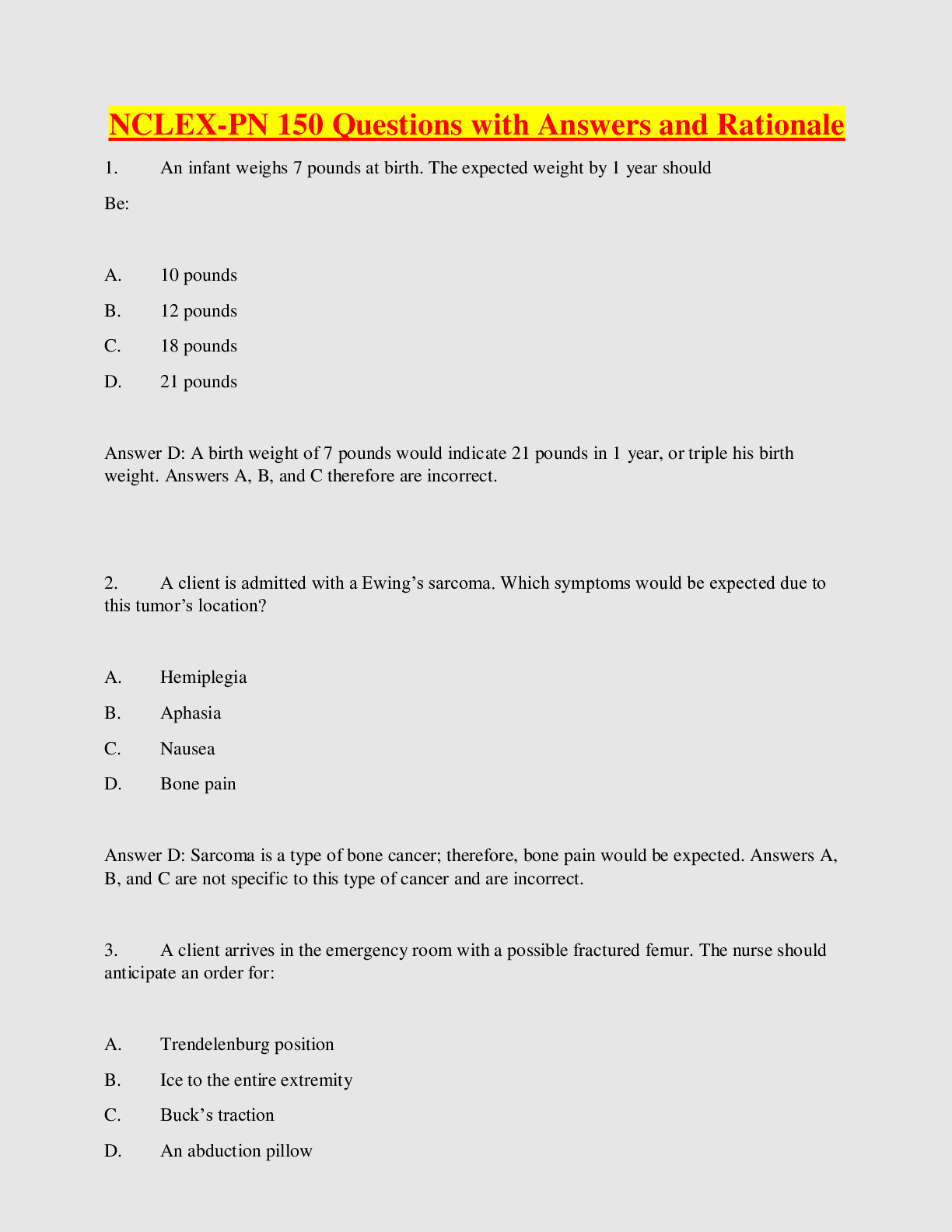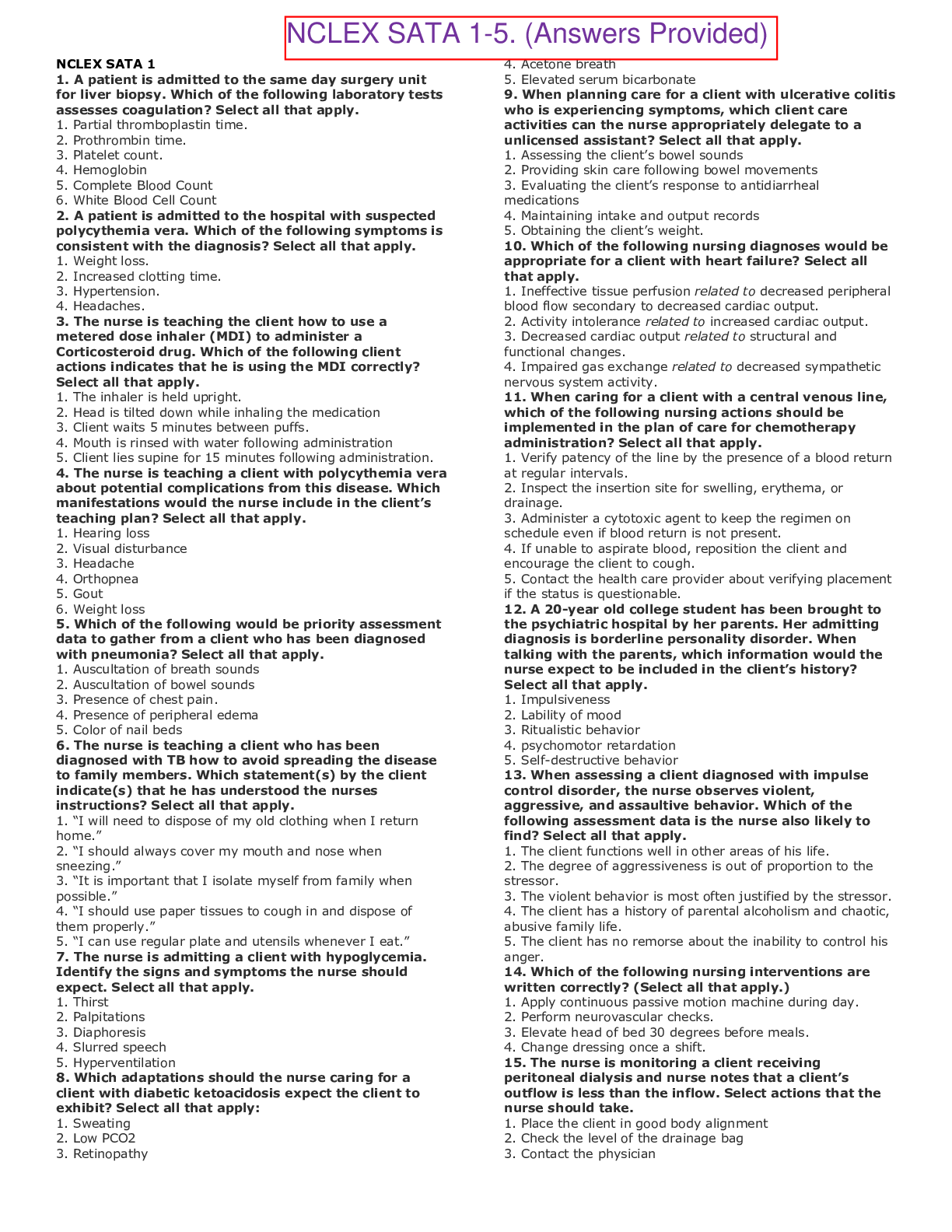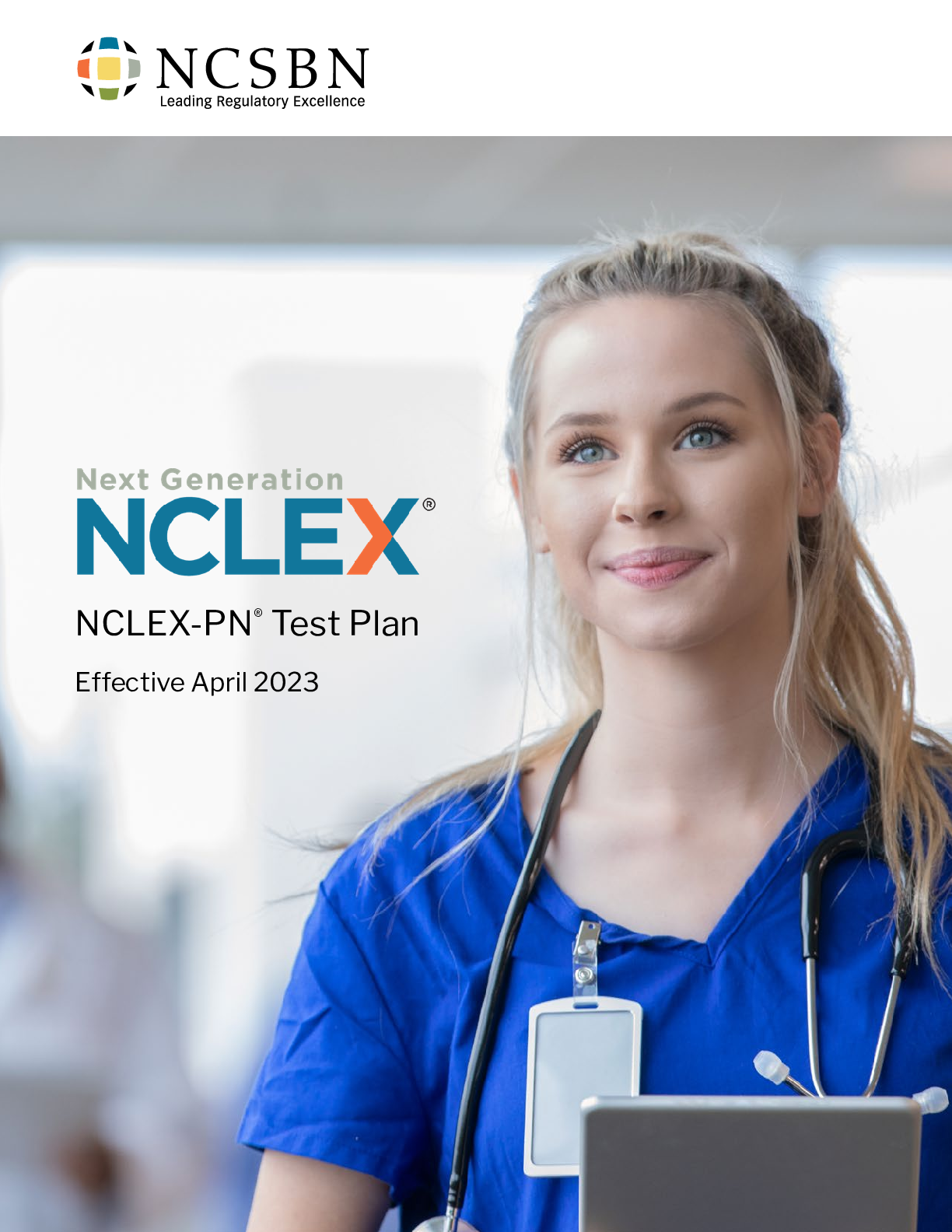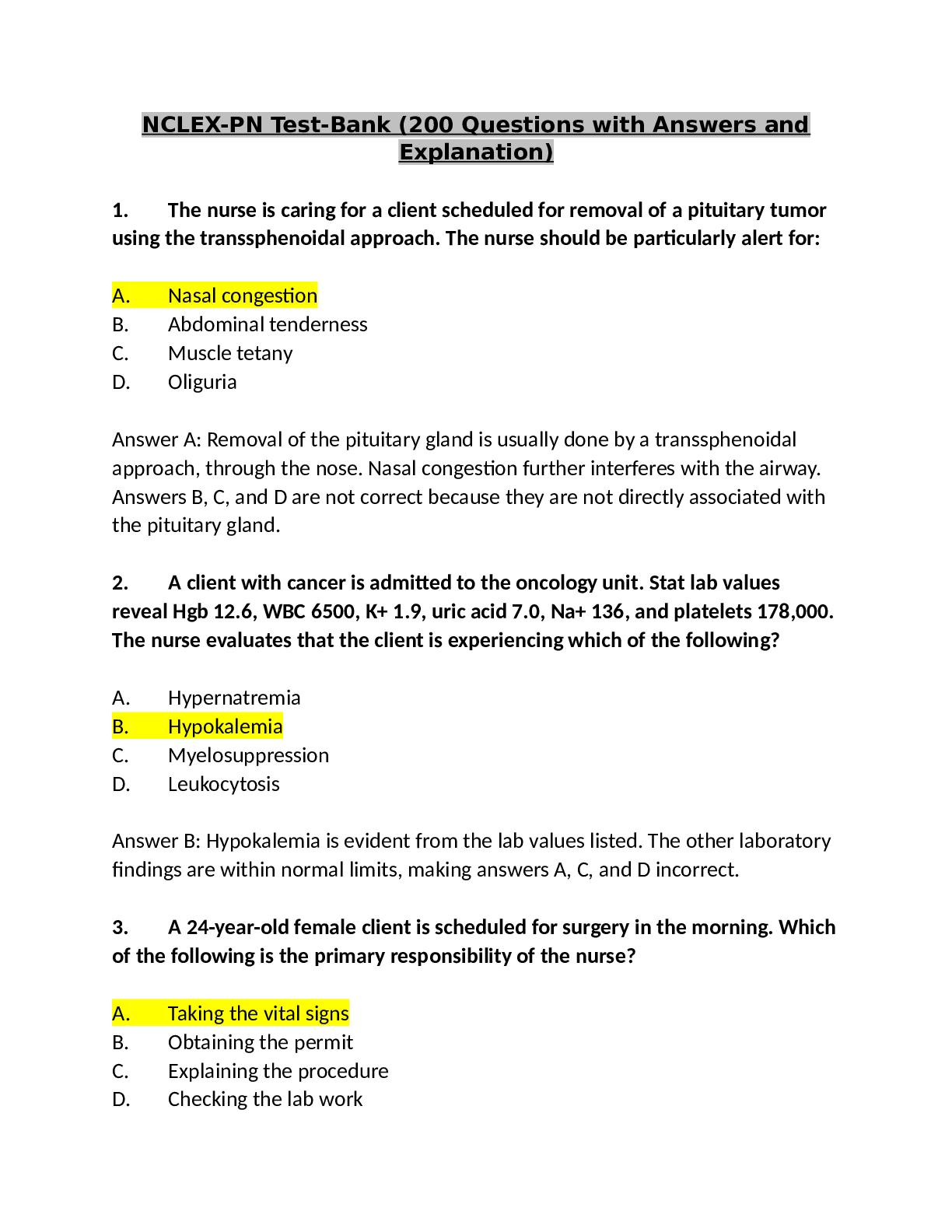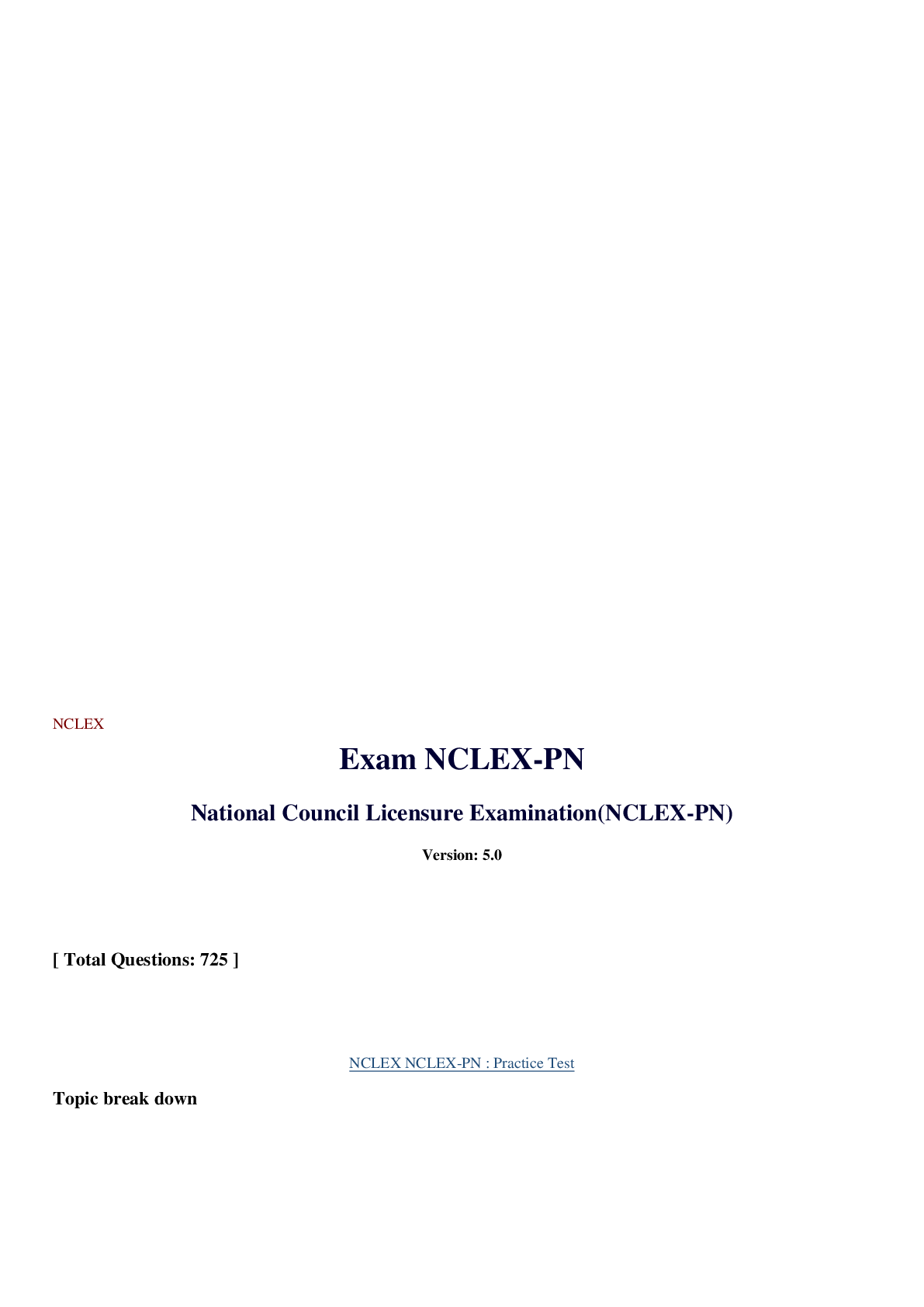*NURSING > NCLEX-PN > PN CAPSTONE NCLEX QUESTIONS_3 ( latest 2020) – Rasmussen College | PNCAPSTONE NCLEX QUESTIONS_3 ( (All)
PN CAPSTONE NCLEX QUESTIONS_3 ( latest 2020) – Rasmussen College | PNCAPSTONE NCLEX QUESTIONS_3 ( latest 2020)
Document Content and Description Below
PN CAPSTONE NCLEX QUESTIONS_3 ( latest 2020) – Rasmussen College 1. If a male client experienced a cerebrovascular accident (CVA) that damaged the hypothalamus, the nurse anticipate that the clie... nt has problems with: a. Body temperature control. b. Balance and equilibrium c. Visual acuity d. Thinking and reasoning 2. A female client admitted to an acute care facility after a car accident develops signs and symptoms of increased intracranial pressure (ICP). The client is intubated and placed on mechanical ventilation to help reduce ICP. To prevent a further rise in ICP caused by suctioning, the nurse anticipates administering which drug endotracheal before suctioning? a. Phenytoin (Dilantin) b. Mannitol (Osmitrol) c. Lidocaine (Xylocaine) d. Furosemide (Lasix) 3. After striking his head on a tree while falling from a ladder, a young man age 18 is admitted to the emergency department. He’s unconscious and his pupils are nonreactive. Which intervention would be the most dangerous for the client? a. Give him a barbiturate b. Place him a mechanical ventilation c. Perform a lumbar puncture d. Elevate the head of his bed 4. When obtaining the health history from a male client with retinal detachment, the nurse expects the client to report: a. Light flashed and floaters in front of the eye b. A recent driving accident while changing lanes c. Headaches, nausea, and redness of the eyes d. Frequent episodes of double vision 5. Which nursing diagnosis takes highest priority for a client with Parkinson’s crisis? a. Imbalanced nutrition: less than body requirements b. Ineffective airway clearance c. Impaired urinary elimination d. Risk for injury 6. To encourage adequate nutritional intake for a female client with Alzheimer’s disease, the nurse should: a. Stay with the client and encourage him to eat b. Help the client fill out his menu c. Give the client privacy during meals d. Fill out the menu for the client 7. The nurse is performing a mental status examination on a male client diagnosed with subdural hematoma. This test assesses which of the following? a. Cerebellar function b. Intellectual function c. Cerebral function d. Sensory function 8. Shortly after admission to an acute care facility, a male client with a seizure disorder develop status epilepticus. The physician orders diazepam (Valium) 10 mg I.V. stat. How soon can the nurse administer a second dose of diazepam, if needed and prescribed? a. In 30 to 45 seconds b. In 10 to 15 minutes c. In 30 to 45 minutes d. In 1 to 2 hours 9. A female complains of periorbital aching, tearing, blurred vision, and photophobia in her right eye. Ophthalmologic examination reveals a small, irregular, nonreactive pupil - a condition resulting from acute iris inflammation (iritis). As part of the client’s therapeutic regimen, the physician prescribes atropine sulfate (Atropisol), two drops of 0.5% solution in the right eye twice daily. Atropine Sulfate belongs to which drug classification? a. Para sympathomimetic agent b. Sympatholytic agent c. Adrenergic blocker d. Cholinergic blocker 10. Emergency medical technicians transport a 27-year-old iron worker to the emergency department. They tell the nurse, “He fell from a two story building. He has a large contusion on his left chest and a hematoma on the left parietal area. He has a compound fracture of his left femur and he’s oximeter with a manual-resuscitation bag.” Which intervention by the nurse has the highest priority? a. Assessing the left leg b. Assessing the pupils c. Placing the client in Trendelenburg’s position d. Assessing level of consciousness 11. An auto mechanic accidentally has battery acid splashed in his eyes. His coworkers irrigate his eyes with water for 20 minutes, and then take him to emergency department of a nearby hospital, where he received emergency care for corneal injury. The physician prescribes dexamethasone (Maxidex Ophthalmic Suspension), two drops of 0.1% solution to be instilled initially into the conjunctival sacs of both eyes every hour; and polymycin B sulfate (Neosporin Ophthalmic), 0.5% ointment to be places in the conjunctival sacs of both eyes every 3 hours. Dexamethasone exerts its therapeutic effect by: a. Increasing the exudative reaction of ocular tissue b. Decreasing leukocyte infiltration at the site of ocular inflammation c. Inhibiting the action of carbonic anhydrase d. Producing a miotic reaction by stimulation and contraction the sphincter muscles of the iris. 12. Nurse April is caring for a client who under a lumbar laminectomy 2 days ago. Which of the following findings should the nurse consider abnormal? a. More back pain than the first postoperative day b. Paresthesia in the dermatomes near the wounds c. Urine retention or incontinence d. Temperature of 99.2F (37.3C) 13. After an eye examination, a male client is diagnosed with open-angle glaucoma. The Physician prescribes pilocarpine ophthalmic solution (Pilocar), 0.25% gtt I, OU QID. based on this prescription, the nurse should teach the client or a family member to administer the drug by: a. Instilling one drop of pilocarpine 0.25% into both eyes daily. b. Instilling one drop of pilocarpine 0.25% into both eyes four times a daily c. Instilling one drop of pilocarpine 0.25% into the right eye daily d. Instilling one drop of pilocarpine 0.25% into the left eye four times daily 14. A female client who’s paralyzed on the left side has been receiving physical therapy and attending teaching sessions about safety. Which behavior indicates that the client accurately understands safety measures related to paralysis? a. The client leaves the side rails down b. The client uses a mirror to inspect the skin c. The client repositions only after being reminded to do so. d. The client hangs the left arm over the side of the wheelchair 15. A male client in the emergency department has a suspected neurologic disorder. To assess gait, the nurse asks the client to take a few steps; with each step, the client’s feet make a half circle. To document the client’s gait, the nurse should use which term? a. Ataxic b. Dystrophic c. Helicopod d. Steppage 16. A client, age 22, is admitted with bacterial meningitis. Which hospital room would be the best choice for this client? a. A private room down the hall from the nurses’ station b. An isolation room three doors from the nurses’ station c. A semiprivate room with a 32-year-old client who has viral meningitis d. A two-bed room with a client who previously had bacterial meningitis 17. A physician diagnoses a client with myasthenia gravis, prescribing pyridostimine (Mestinon), 60 mg P.O. every 3 hours. Before administering this anticholinesterase agent, the nurse reviews the client’s history. Which preexisting condition would contraindicate the use of pyridostigmine? a. Ulcerative colitis b. Blood dyscrasia c. Intestinal obstruction d. Spinal cord injury 18. Select the member of the healthcare team that is paired with one of the main functions of this team member. a. Occupational therapist: Gait exercises b. Physical therapist: The provision of assistive devices to facilitate the activities of daily living c. Speech and language therapist: The treatment of swallowing disorders d. Case manager: ordering medication and treatments 19. Failing health, malnutrition, and wasting as a result of chronic diseases are all associated with: a. Surgical asepsis b. Catabolism c. Cachexia d. Venous stasis 20. Select all the possible opportunistic infections that adversely affect HIV/AIDS infected patients. a. Visual losses b. Kaposi’s sarcoma c. Wilms’ sarcoma d. Tuberculosis e. Peripheral neuropathy f. Toxoplasma gondii 21. What can help reduce a patient’s anxiety and postsurgical pain? a. Preoperative teaching b. Preoperative checklist c. Psychological counseling d. Preoperative medication 22. Which disease decreases the metabolic rate? a. Cancer b. Hypothyroidism c. Chronic obstructive pulmonary disease d. Cardia failure 23. When caring for an infant during cardiac arrest, which pulse must be palpated to determine cardiac function? a. Carotid b. Brachial c. Pedal d. Radial 24. The patent should be sitting when deep breathing and coughing because this position: a. Is physically more comfortable for the patient b. Helps the patient to support their incision with a pillow c. Loosen respiratory secretions d. Allows the patient to observe their area and relax 25. The primary difference between practical nursing licensure and a nursing certification in an area of practice is that nursing licensure is: a. Insures competency and a nursing certification validates years of experience b. Mandated by the American nurses Association and a nursing certification are not. c. Is legally mandated by the state and a nursing certification is not d. Renewed every two years and a nursing certification is renewed every five years. 26. What intervention is the best to relieve constipation during pregnancy? a. Increase the consumption of fruits and vegetables b. Taking a mild over the counter laxative c. Lying flat on back when sleeping d. Reduction of iron intake by half or more 27. The embryonic period during pregnancy takes place from: a. Weeks 1 to 12 b. Weeks 1 to 10 c. Weeks 3 to 5 d. Weeks 6 to 10 28. Place these human needs in order from the greatest priority to the least priority using #1 as the greatest priority and #5 as the least of all in terms of priority. a. Self-esteem and esteem by others 4 b. Self-actualization 5 c. Psychological needs 2 d. Love and belonging 3 e. Physiological needs 1 29. During which week does the fetal heart begin pumping its own blood? a. 3rd week b. 5th week c. 9th week d. 6th week 30. Which of the following is a vector of infection? a. A contaminated ball b. A contaminated thermometer c. An infected person d. An infectious fly 31. Which oral disorder appears as a yellow of white spots on the oral mucosa that are not possible to scrape off without bleeding? a. Herpes simplex b. Candidiasis c. Alphthous ulcers d. Leukoplakia 32. Which type of cancer has the poorest prognosis? a. Squamous cell carcinoma b. Breast cancer c. Pancreatic cancer d. Gastric cancer 33. A cesarean mode of delivery, often utilized for various reasons, is the most common mode for females with which pelvic type? a. Android b. Anthropoid c. Gynecoid d. Platypelloid 34. How many bones make up a newborn’s skull? a. 8 b. 4 c. 6 d. 5 35. You have been asked to speak at a new nursing assistants’ orientation class about infection control and handwashing techniques. What would you include in this teaching? a. Demonstrate the correct one minute handwashing procedure using soap and running water b. Demonstrate the correct 2 minute handwashing procedure using soap and running water c. Using hot water so that the natural fats on the skins are emulsified with the soap d. Using cold water so that the natural fats on the skin are emulsified with the soap 36. How many minims are contained in 1 milliliter? a. Between 10-11 b. 12 c. 20 d. between 15 or 16 37. Periwound macerations occurs when: a. the skin around the wound softens and is damaged b. selecting a dressing individualized to the type of wound c. negative-pressure to “air out” the wound is used d. the skin around the wound dries out and hardens 38. Which patient is at greatest risk for cholelithiasis and choledocholithiasis? a. A 70 year old male patient who has liver disease b. A 70 year old female patient who has liver disease c. A 50 years old male patient who is Asian d. A 50 year female patient who is Asian 39. Select the method of special precautions that is accurately paired with the personal protective equipment that s minimally required in order to prevent the spread of infection a. Contact precautions: gowns, gloves, and ask b. Droplet precautions: face mask c. Airborne transmission precautions: negative pressure room d. Contact precautions: gloves 40. Which statement about Meniere’s disease is accurate and true? a. Meniere’s disease most commonly occurs among members of the elderly population b. Meniere’s disease is insidious and it always affects both ears c. Meniere’s disease occurs with an impairment of the second cranial nerve d. Antiemetic drugs are used for the treatment of patients affected with Meniere’s disease 41. Which of these patients is affect with a healthcare acquired infection? a. A 18 year old male patient who developed an intravenous line infection two days after insertion b. A 72 year old male patient who is at risk for infection secondary to AIDS/HIV c. A 67 year old female patient who was admitted with a urinary tract infection d. A 5 year old pediatric patient who develops the measles rash 3 days after admission 42. The stages of infection in correct sequential order are: a. The prodromal, incubation, illness and convalescence stages b. The incubation, prodromal illness and convalescence stages c. The prodromal, primary, secondary and tertiary stages d. The inflammation, infection and immunity stages 43. What is the single most important thing that nurses do in order to prevent the spread of infection? a. Applying standard precautions b. Using personal protective equipment c. adhering to the principles of asepsis d. Handwashing 44. Rh negative maternal blood indicates: a. An incompatibility in the blood between the mother and fetus b. That antibodies in the mothers blood are attacking her baby’s blood c. The mother will require a blood transfusion at the time of delivery d. The mother does not have specific marker on her red blood cells 45. Low birth weight is defined as a newborn’s weight of: a. 2500 grams or less at birth weight, regardless of gestational age b. 1500 grams or less at birth, regardless of gestation age c. 2500 grams or less at birth, according to gestational age d. 1500 grams or less at birth, according to gestational age 46. Which of the following actions, if performed by the nurse, would be considered negligence? a. The nurse obtains a Guthrie blood test on a 4-day-old-infant b. The nurse massages lotion on the abdomen of a 3-year-old diagnosed with Wilm’s tumor c. The nurse instructs a 5 year old asthmatic to blow on a pinwheel d. The nurse plays kick ball with a 10year old with juvenile arthritis(JA) 47. The nurse in the same-day surgery department cares for a 77-year-old woman after a sigmoidoscopy. Which of the following symptoms, if exhibited by the woman an hour after the procedure, would MOST concern the nurse? a. The client complains of fullness and pressure in her abdomen b. The client complains of grogginess and thirst c. The client complains of lightheadedness and dizziness d. The client complains of mild pain and cramping in her abdomen 48. The nurse is discharging a patient from an inpatient alcohol treatment unit. Which of the following statements, if made by the patient’s wife, indicates to the nurse that the family is coping adaptively? a. “My husband will do well as long as I keep him engaged in activities that he likes.” b. “My focus is learning how to live my life.” c. “I am so glad that our problems are behind us.” d. “I’ll make sure that the children don’t give my husband any problems.” 49. The nurse is caring for a patient with cervical cancer. The nurse notes that the radium implant has become dislodged. Which of the following actions should the nurse take FIRST? a. Stay with the patient and contact the radiology b. Wrap the implant in a blanket and place it behind the lead shield c. Obtain a dosimeter reading on the patient and report it to the physician d. Pick up the implant with long-handled forceps and place it in a lead container 50. The nurse has reviewed the charts of four antepartum women. Which woman is at greater risk for having a child with a cleft lip and palate? a. A 22 year old oriental woman who is having a girl b. A 25 year old native American female who is having a boy c. A 35 year old African American woman who is having a boy d. A 40 year old Caucasian who is having a girl 51. A 22-year-old woman in her second trimester of pregnancy tells the clinic nurse that her child has been asking questions “about sex.” The client asks the nurse what she should tell her 5-year-old son. Which of the following statements, if made by the nurse, is BEST? a. “Answer your son’s questions in a matter-of-fact manner, in words that he will understand.” b. “Buy a book about sex designed for young children and read it with your son.” c. “Tell your son that this subject is complicated, and you will discuss it with him as he gets older.” d. “Have your son touch your abdomen and tell him about your pregnancy.” 52. The nurse is observing a LPN/LVN administer iron dextran (DexFerrum) IM. It is MOST important for the nurse to give which of the following instructions? a. “Massage the injection site for one minute after the injection of the medicine.” b. “Tap out the air bubble prior to administering the medication.” c. “Release the skin prior to withdrawing the needle.” d. “Change the needle after drawing up the medication.” 53. A nurse is caring for clients in the mental health clinic. A women comes to the clinic complaining of insomnia and anorexia. The patient tearfully tells the nurse that she was laid off from a job that she had held for 15 years. Which of the following responses, if made by the nurse, is MOST appropriate? a. “Did your company give you a severance package?” b. “focus on the fact that you have a c. “Losing a job is common nowadays.” d. “Tell me what happened.” 54. The nurse is teaching a 45-year-old woman how to increase the potassium in her diet. The woman says she knows bananas are high in potassium, but she doesn’t like their taste. What foods should the nurse recommend the client include in her diet? a. Potatoes, spinach, raisins b. Rhubarb, tofu, celery c. Carrots, broccoli, yogurt d. Onions, corn, oatmeal 55. A 68-year-old woman diagnosed with thrombocytopenia due to acute lymphocytic leukemia is admitted to the hospital. The nurse should assign the patient a. To a private room so she will not infect other patients and health care workers. b. To private room so she will not be infected by other patients and health care workers c. To a semiprivate room so she will have stimulation during her hospitalization d. To a semiprivate room so she will have the opportunity to express her feelings about her illness. 56. The nurse cares for a 46-year-old woman after a traditional cholecystectomy. The patient has a nasogastric tube connected to suction, an IV of D5W infusing into her right arm, and a T-tube and Penrose drain in place. The nurse would be MOST concerned by which of the following findings? a. The systolic blood pressure is 10 mmHg, lower than it was preoperatively b. There is 250 cc of bloody drainage from the t-tube during the first 24 hrs. c. There is 30 cc of Serosanguineous drainage in the Penrose drain during the first 24 hrs. d. The patient experiences a 4 degree temperature elevation the evening after surgery 57. The nurse is leading an in service about management issues. The nurse would intervene if a nurse made which of the following statements? a. “It is my responsibility to ensure that the consent form has been signed and attached to the patient’s chart prior to surgery.” b. “It is my responsibility to witness the signature of the client before surgery is performed.” c. “It is my responsibility to answer questions that the patient may have prior to surgery.” d. “It is my responsibility to provide a detailed description of the surgery and ask the patient to sign the consent form.” 58. A patient with a history of alcoholism is brought to the emergency room in an agitated state. He is vomiting and diaphoretic. Had his last drink five hours ago. The nurse would expect to administer which of the following medications? a. Chlordiazepoxide hydrochloride (Librium) b. Disulfiram (Antabuse) c. Methadone hydrochloride (dolophine) d. Naloxone hydrochloride (narcan) 59. The nurse is caring for a patient with an acute myocardial infarction. Which of the following laboratory findings would MOST concern the nurse? a. Erythrocyte sedimentation rate (ESR)-10 mm/h b. Hematocrit (Hct)-42% c. Creatinine kinase (CK)-350 U/ml d. Serum glucose- 100 mg/dL 60. The nurse has completed discharge instructions for a primigravida woman who is 29 weeks gestation and hospitalized for treatment of deep vein thrombosis. Which of the following statements, if made by the patient to the nurse, indicates that teaching has been successful? a. “I should check my leg once a week.” b. “I will message my leg nightly.” c. “I can take Pepto-Bismol for diarrhea.” d. “I will give myself heparin every day.” 61. At the advice of the physician, a client with hypertension attends classes to help him quit smoking. One month later the client visits the clinic, and the nurse notes a package of cigarettes in his pocket. Which of the following statements, if made by the nurse, is MOST appropriate? a. “I see that you have cigarettes in your pocket.” b. “Please give me the cigarettes.” c. “I’ll have to report this to the physician.” d. “You’ll have to enroll in another class.” 62. A 65-year-old woman recovering from a right below-knee amputation (BKA) asks the nurse why the bandage is applied in a “figure-eight.” Which of the following explanations, if made by the nurse, is MOST accurate? a. “It decreases the possibly of infection.” b. “It helps to minimize postoperative pain.” c. “It reduces the possibility of clot formation.” d. “It reduces postoperative swelling.” 63. While inserting a nasogastric tube, the nurse should use which of the following protective measures? a. Gloves, gown, goggles, and a surgical cap b. Sterile gloves, mask, plastic bags, and gowns. c. Gloves, gown, mask, and goggles. d. Double gloves, goggles, mask, and surgical cap 64. Your 54 year old male HIV positive patient has just expired. How should you care for this deceased patient? a. Bathe the patient but it is no longer necessary to use standard precaution because patient is deceased b. Place the patient in a negative pressure isolated area of the morgue c. Double shroud the patient to prevent the spread of infection d. Bathe the patient using the same standard precautions you used when he was alive 65. Select the types of pain that are accurately coupled with an example of it. Select all that are correct. a. Radicular pain: a Broken Bone b. Central neuropathic pain: a spinal cord injury c. Peripheral neuropathic pain: a fractured leg bone d. Chronic pain: a stab wound to the chest e. Nociceptive pain: a laceration f. Radicular pain: a herniated spinal disc. 66. Which nursing diagnosis is the most commonly used among patients who are affected with fibromyalgia? a. Decreased self-care in the activities of daily living related to fatigue b. Impaired mental functioning related to electrolyte imbalances c. Increased vigilance secondary to electrolyte imbalances d. At risk for a swallowing disorder related to fibromyalgia 67. Alcohol, caffeine or drugs are high risk factors that all fall under which broad classification of risk factors? a. Social demographic b. Environmental c. Biophysical d. Psychosocial 68. Multifetal pregnancies with triplets occurs at a rate of 1 in 8,100 births, but twins occur much more frequently with a rate of: a. 1 in 85 births b. 1 in 5400 births c. 1 in 2700 births d. 1 in 540 births 69. When a woman has miscarried in three or more consecutive pregnancies, it is referred to as which type of spontaneous abortions? a. Inevitable b. Missed c. Habitual 70. The normal sodium level in the body is: a. 135-145 mEq b. 3-5 mEq c. 135-145 mEq d. 3-5 mEq [Show More]
Last updated: 1 year ago
Preview 1 out of 17 pages

Reviews( 0 )
Document information
Connected school, study & course
About the document
Uploaded On
Jul 30, 2020
Number of pages
17
Written in
Additional information
This document has been written for:
Uploaded
Jul 30, 2020
Downloads
0
Views
95

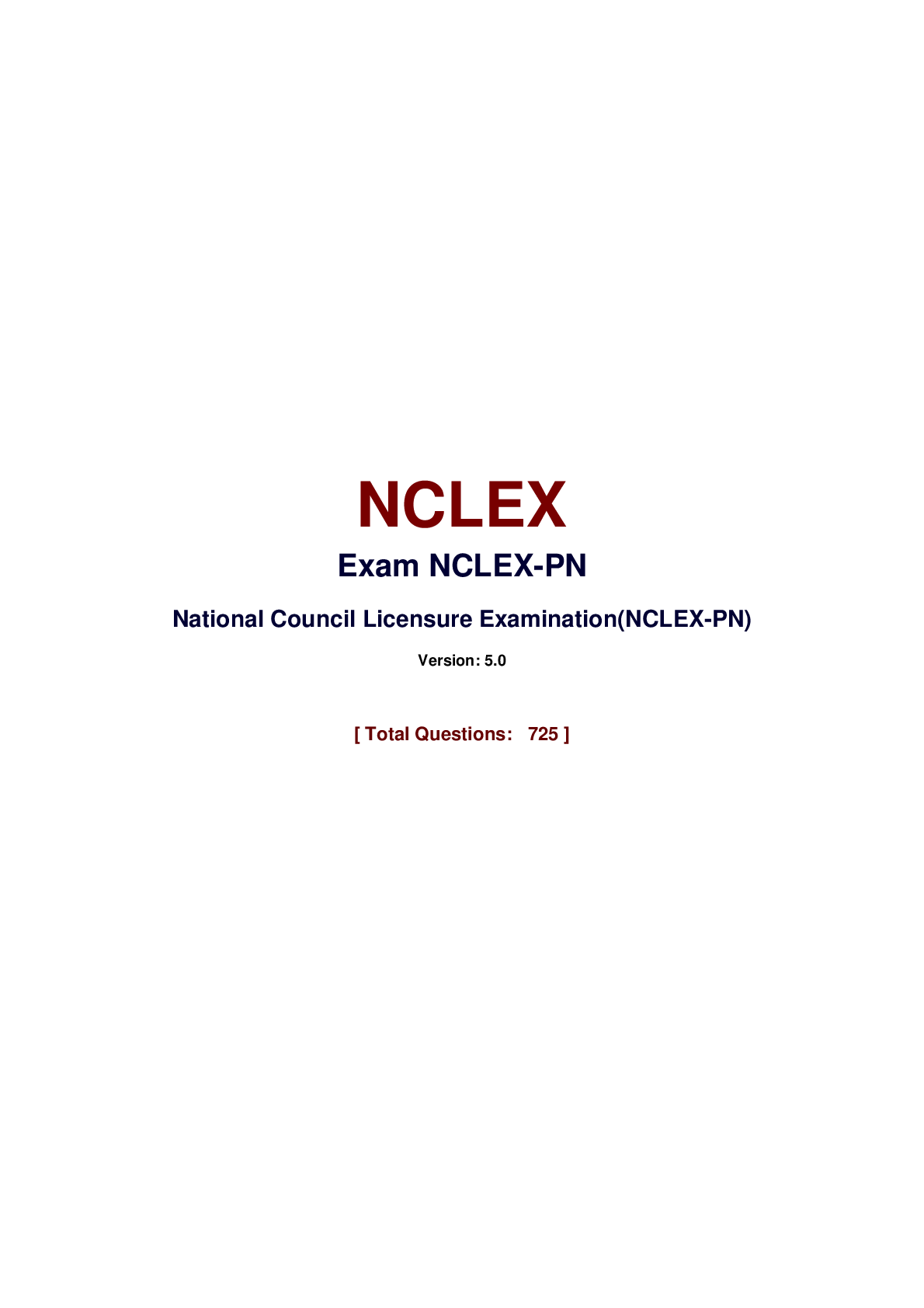

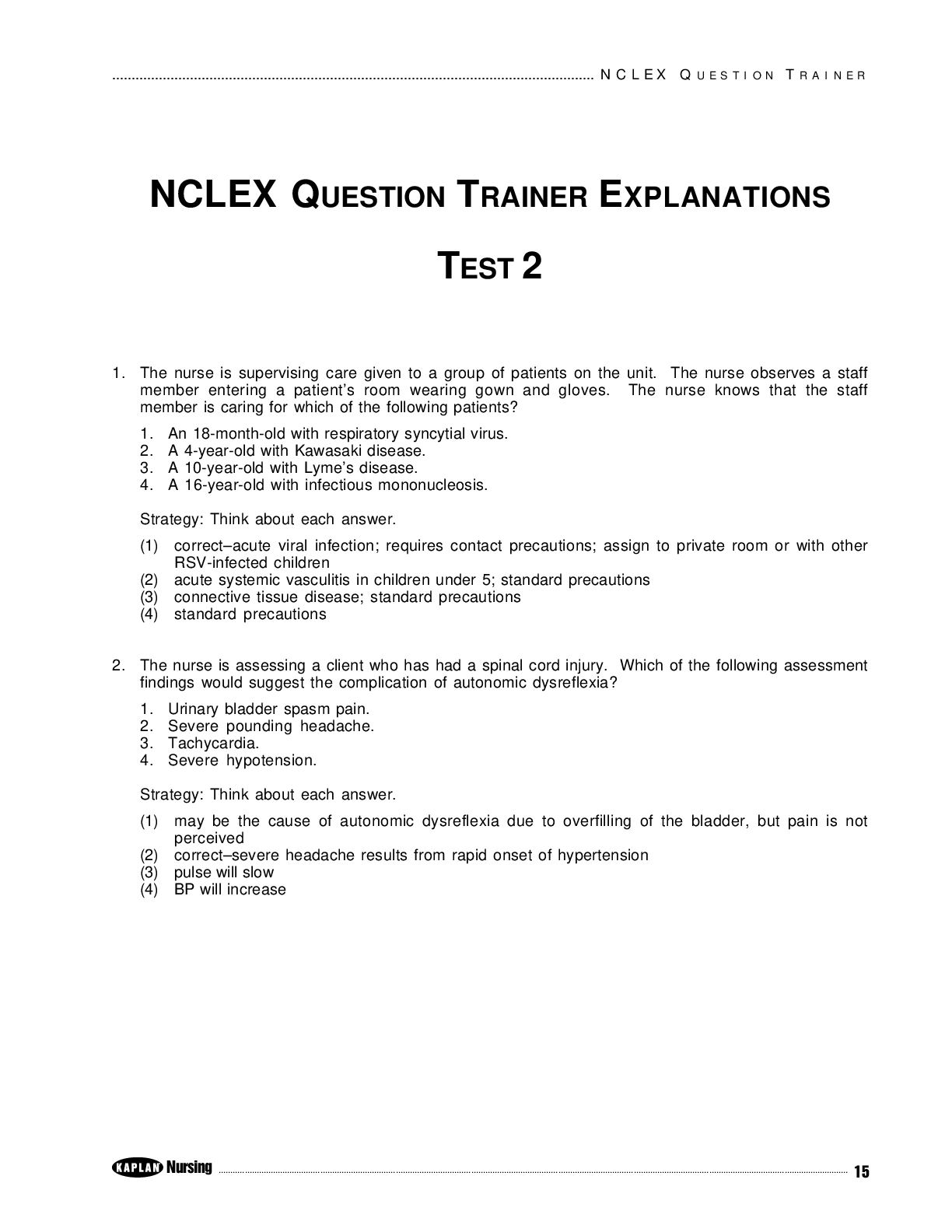
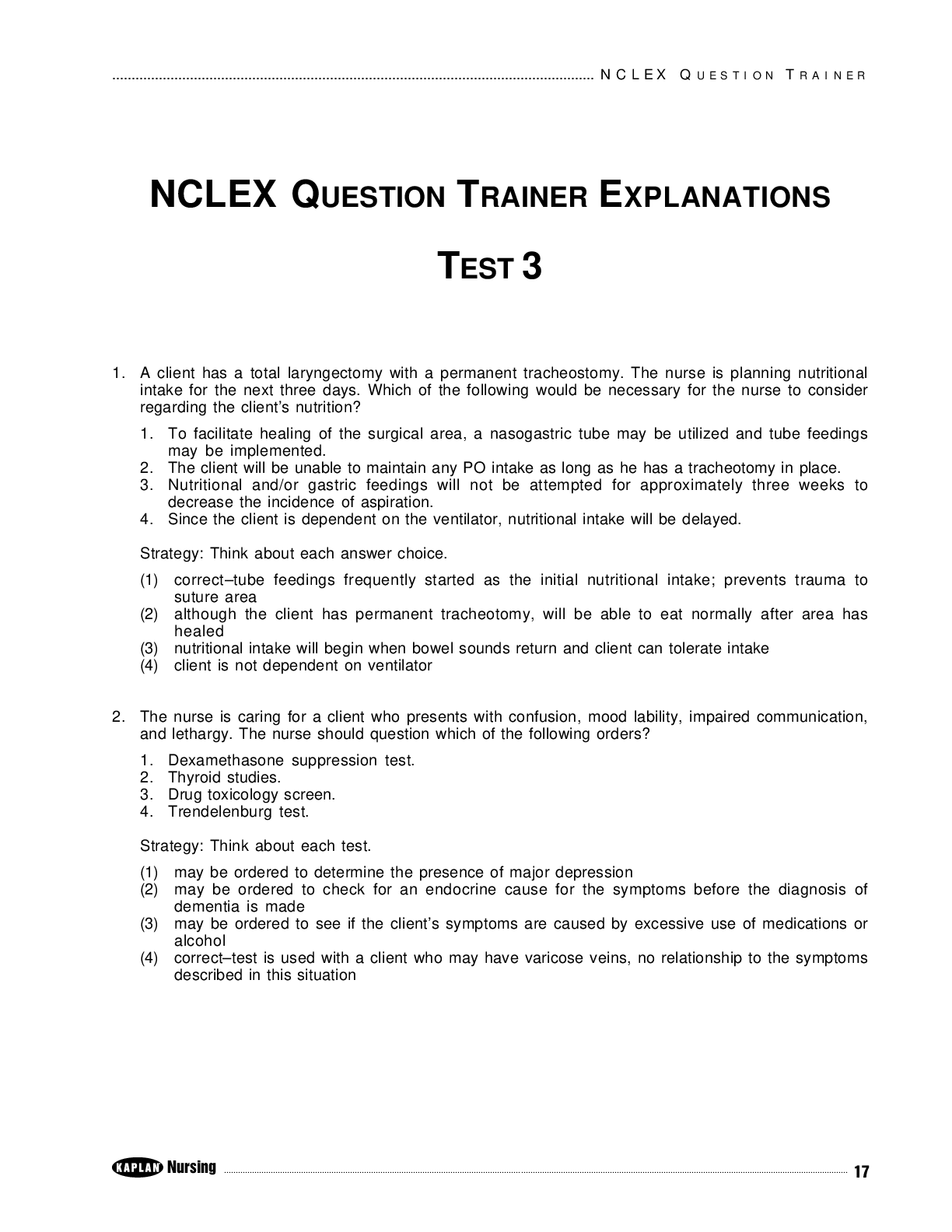
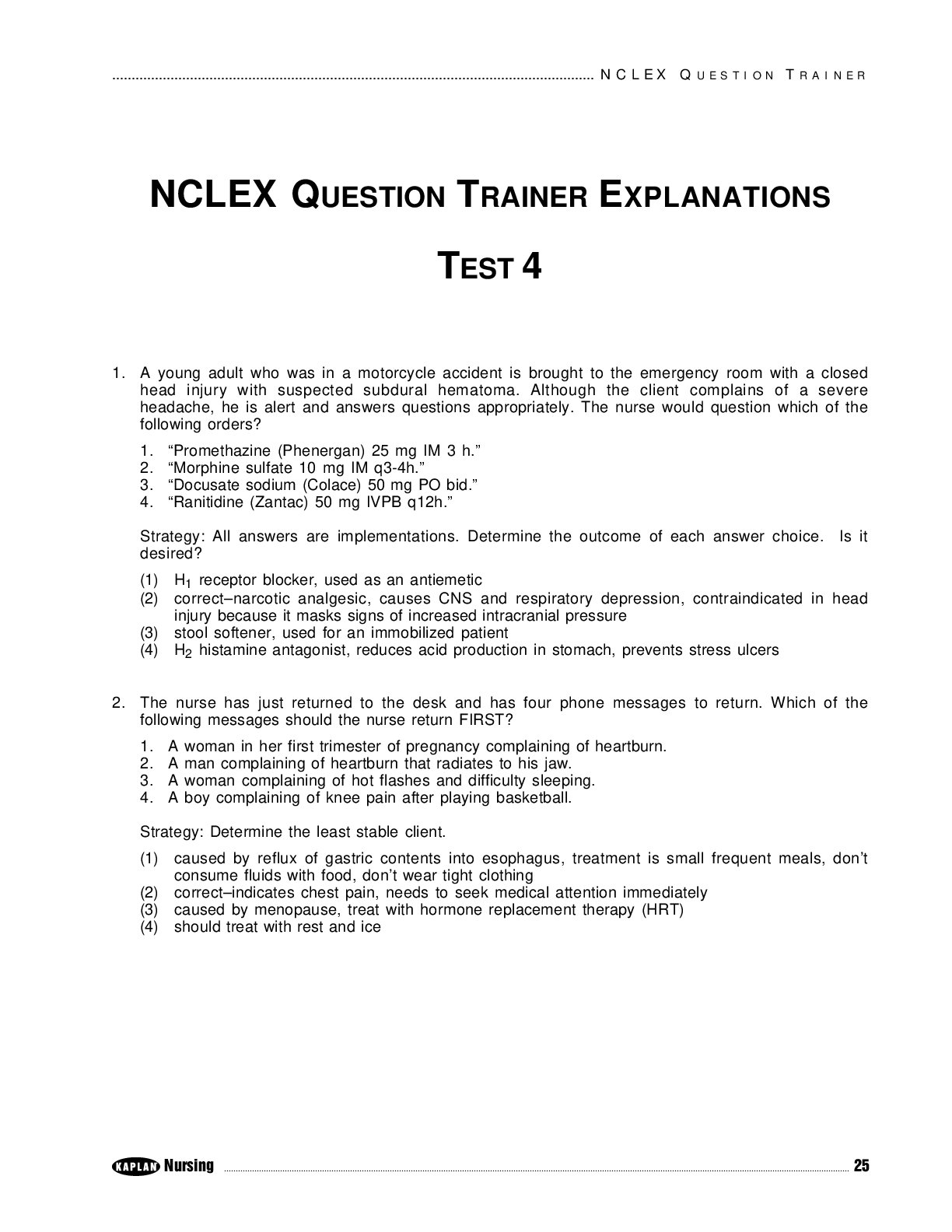
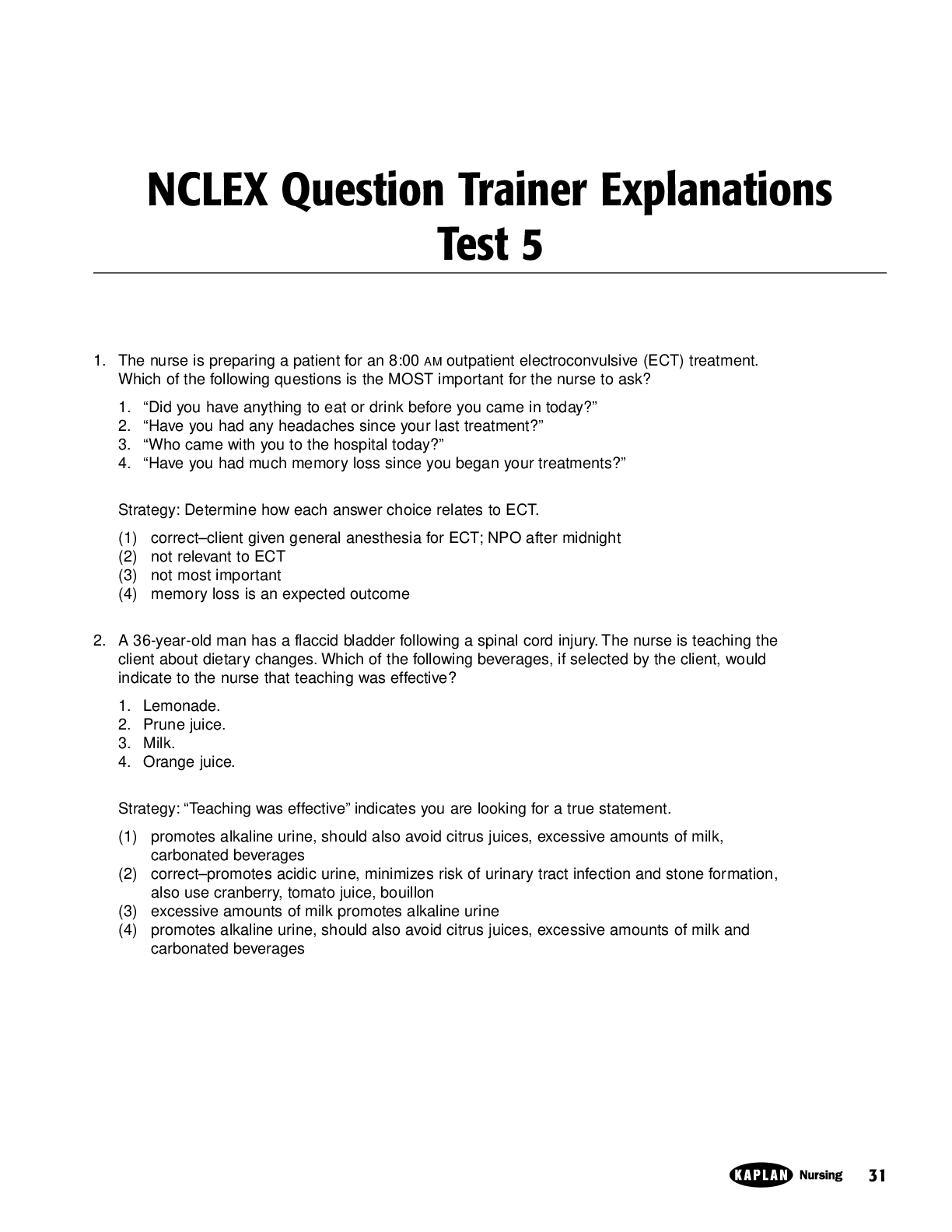
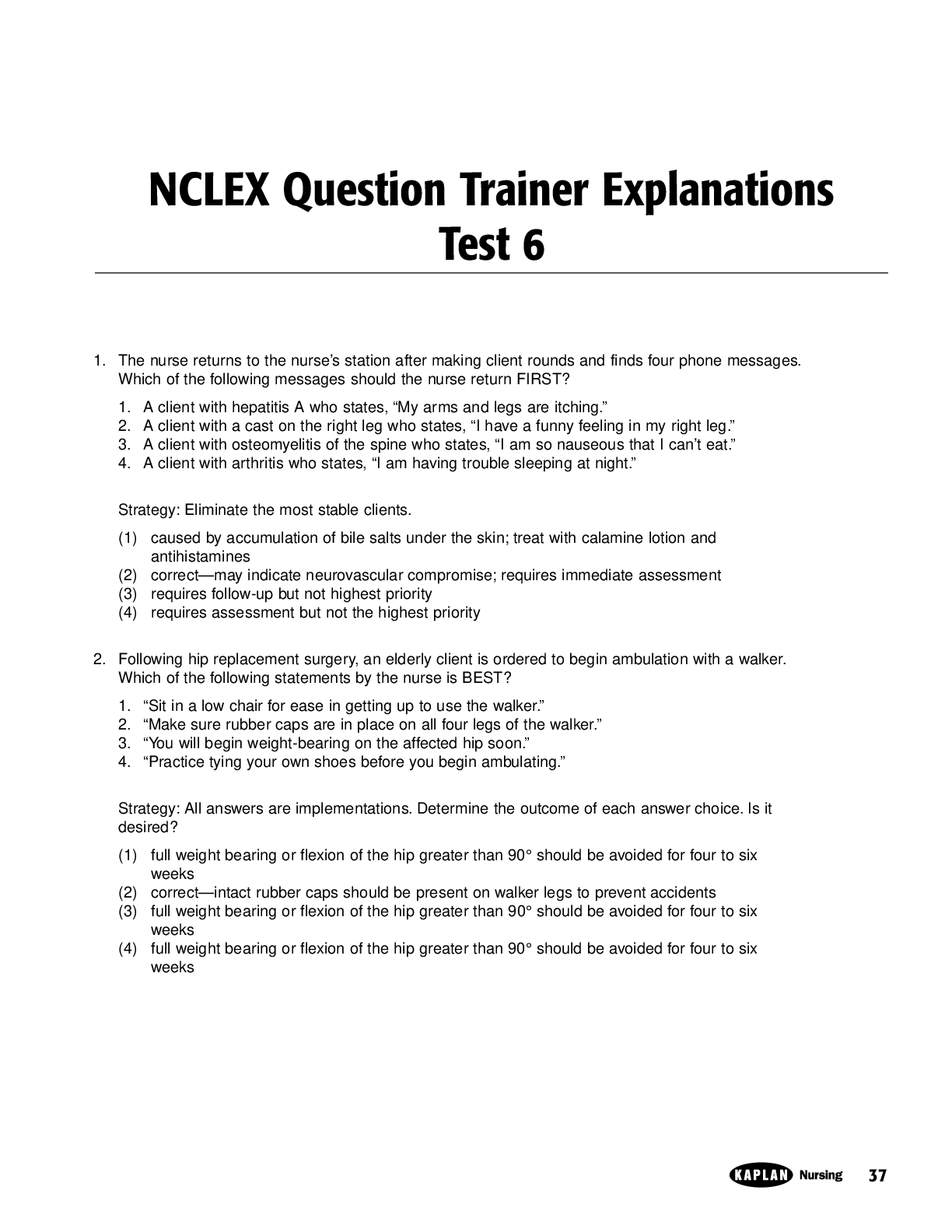
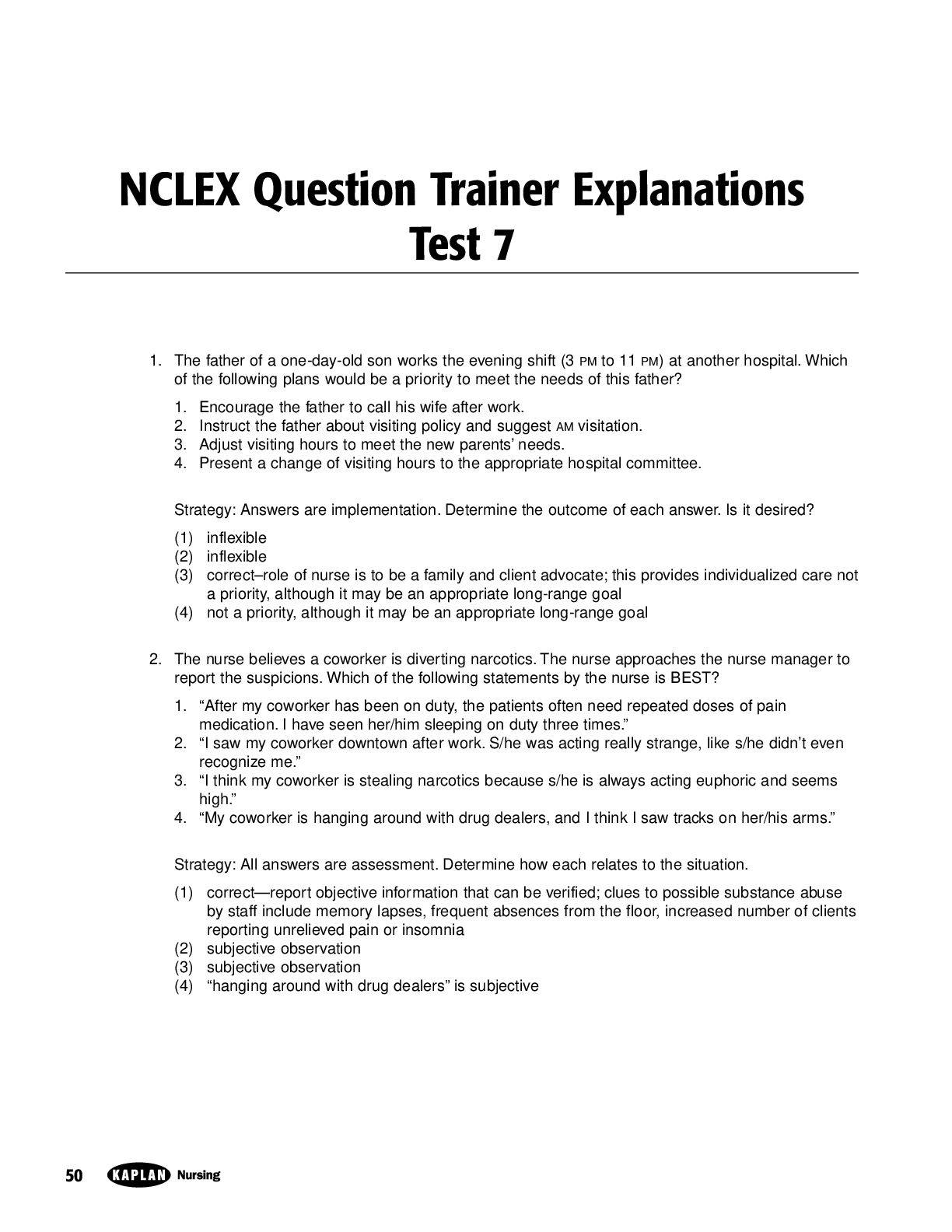
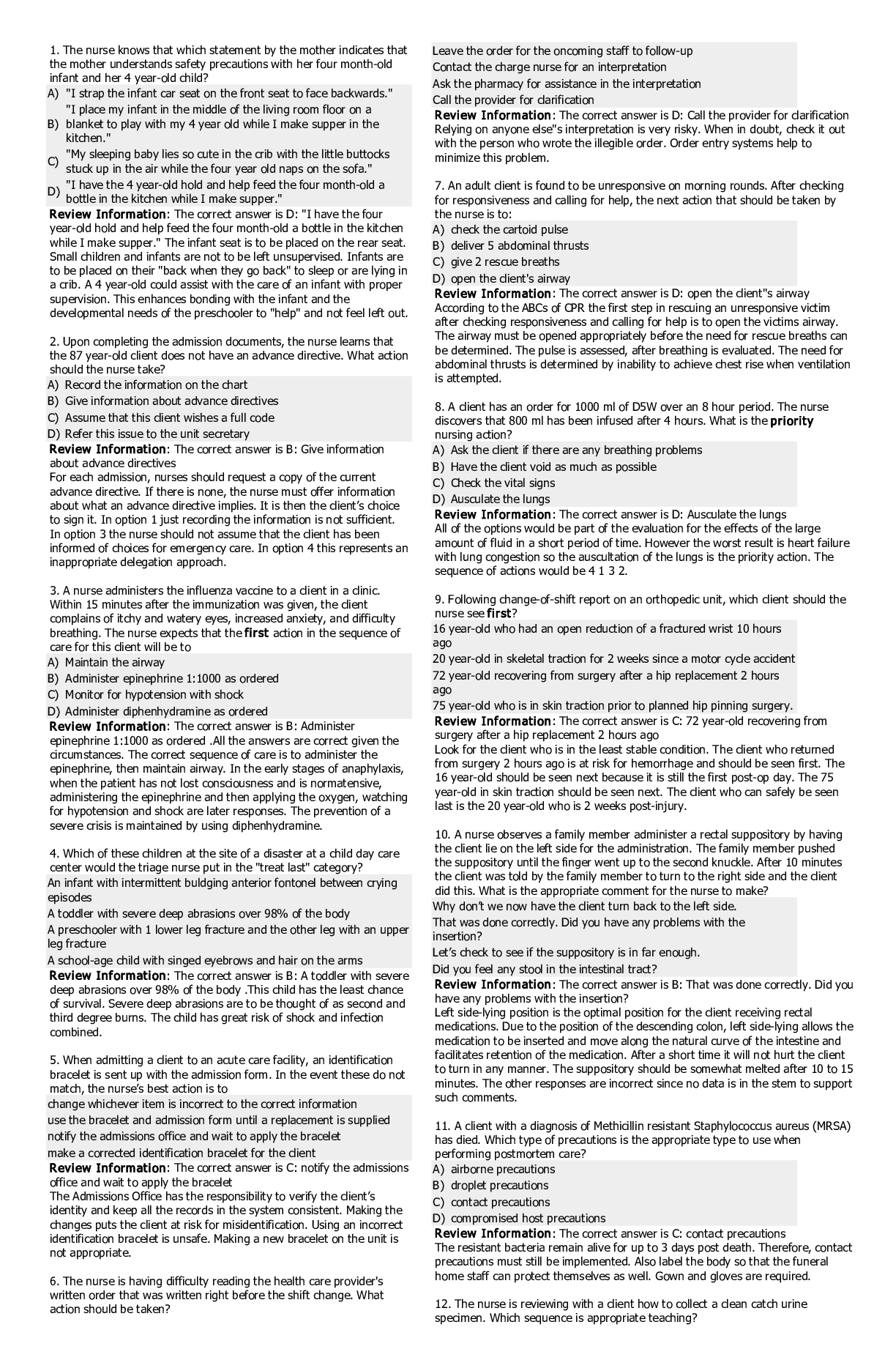
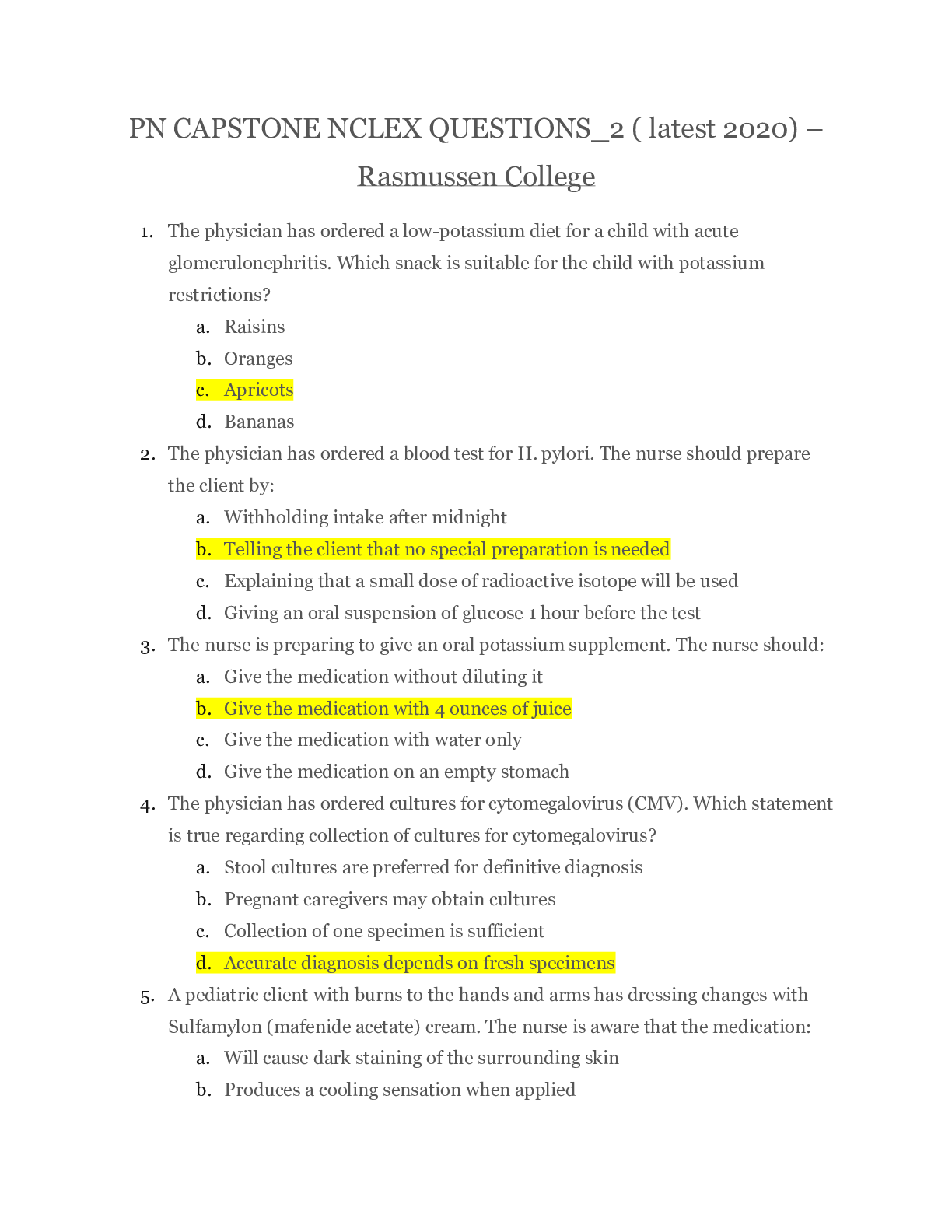
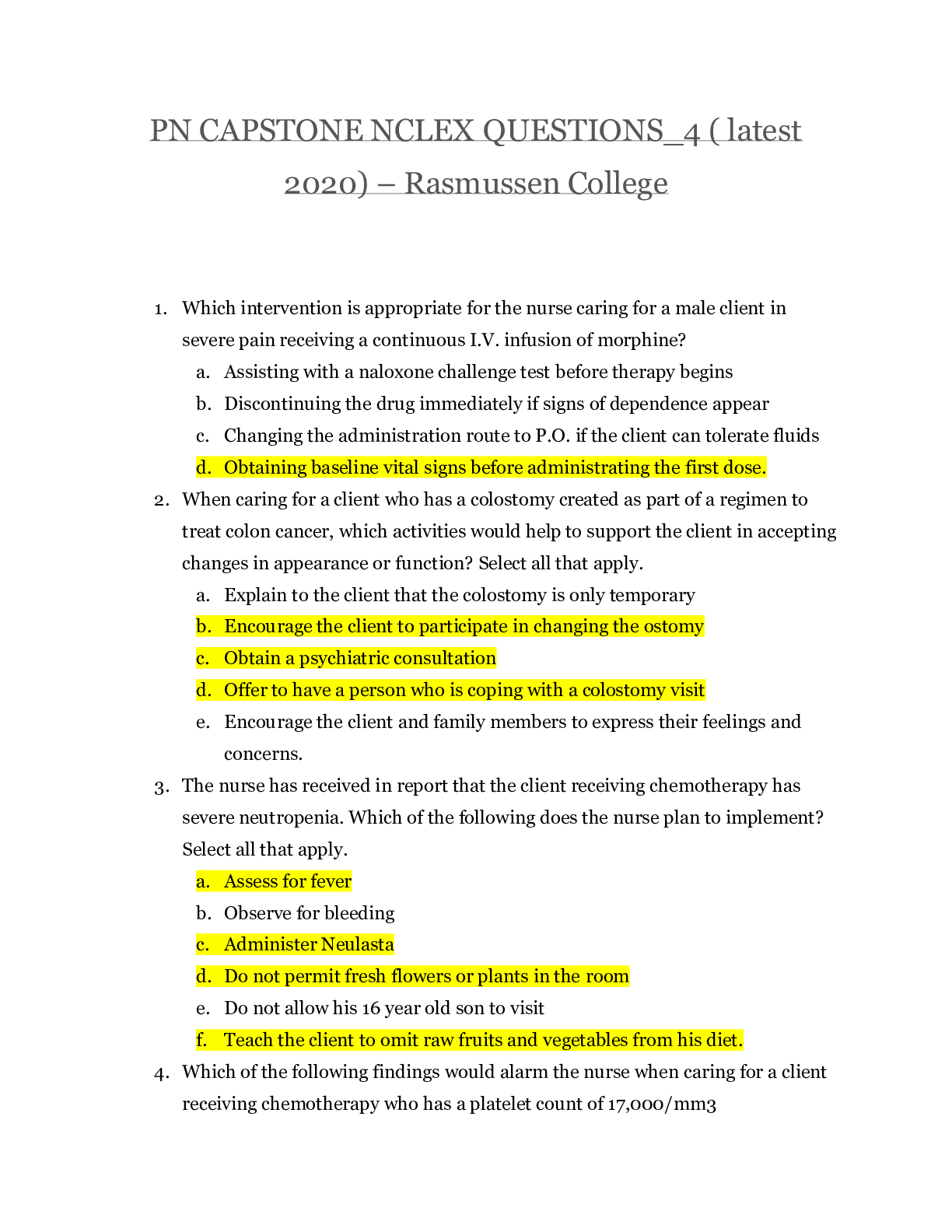



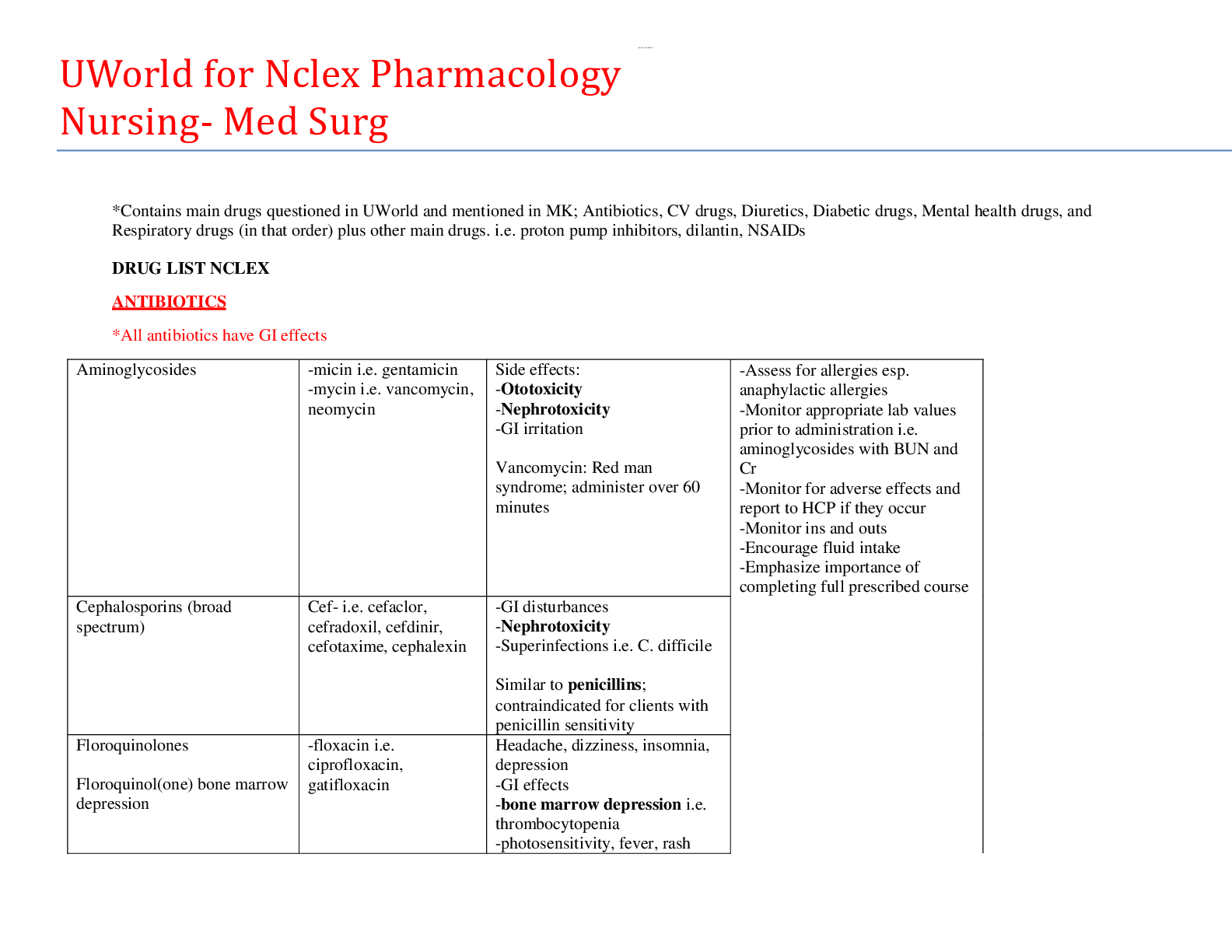

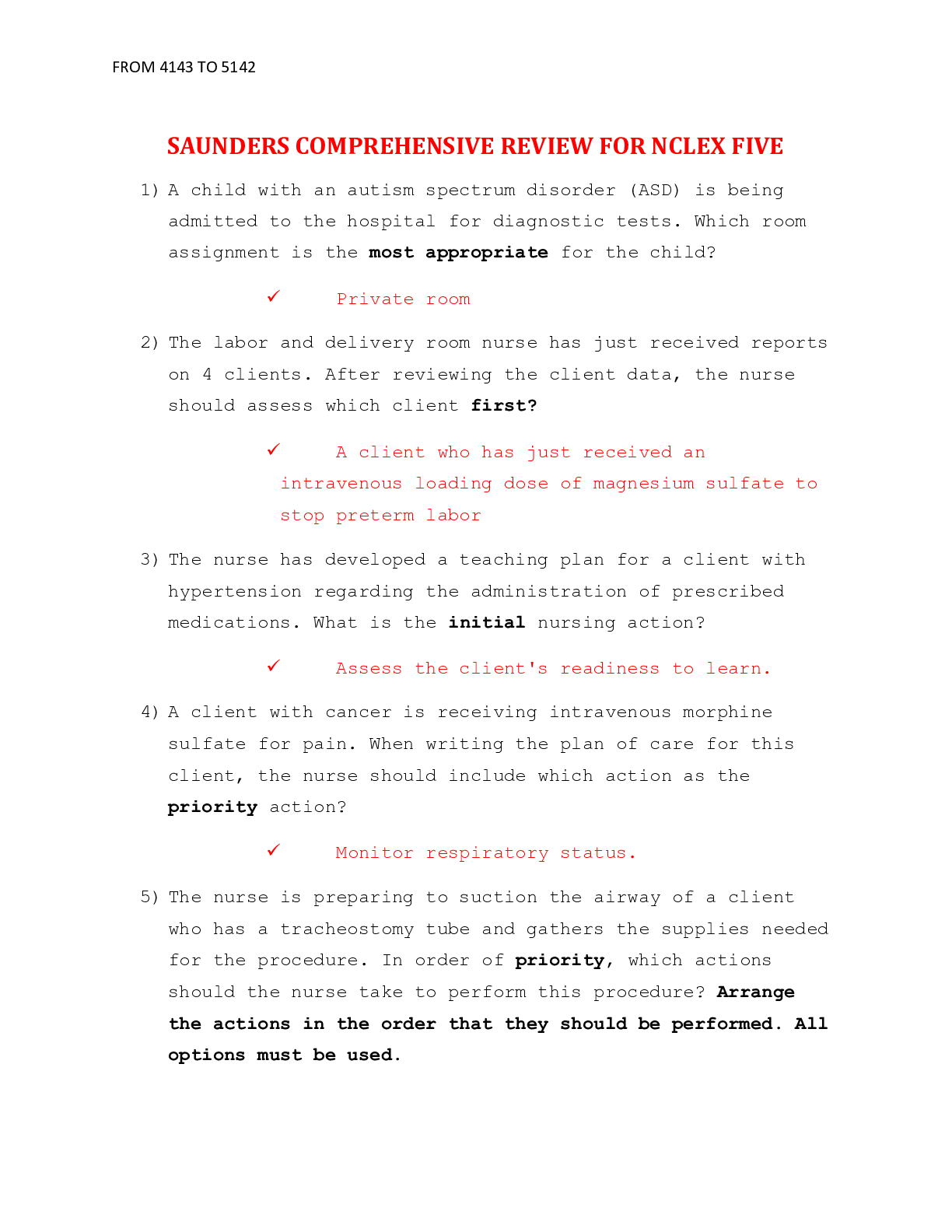
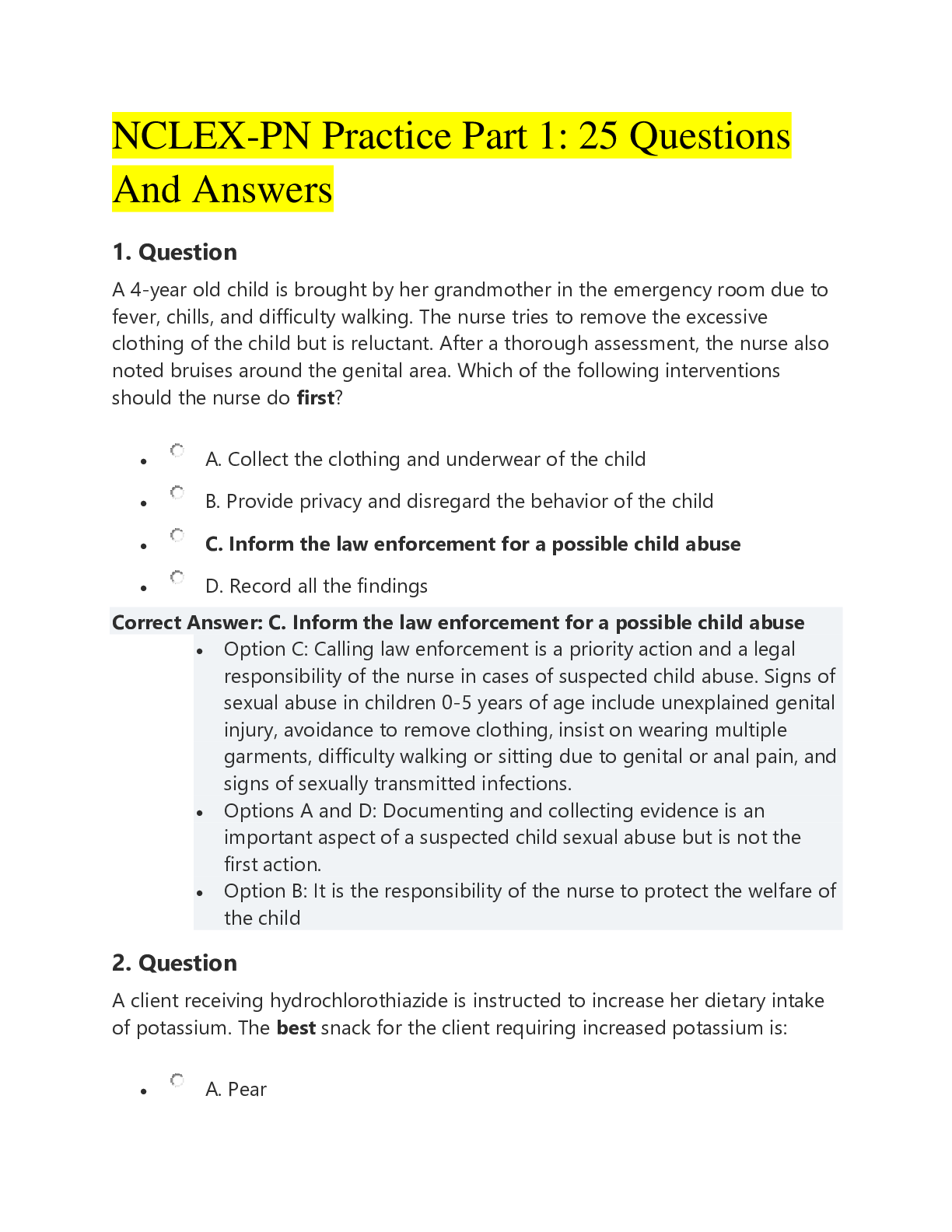
.png)
